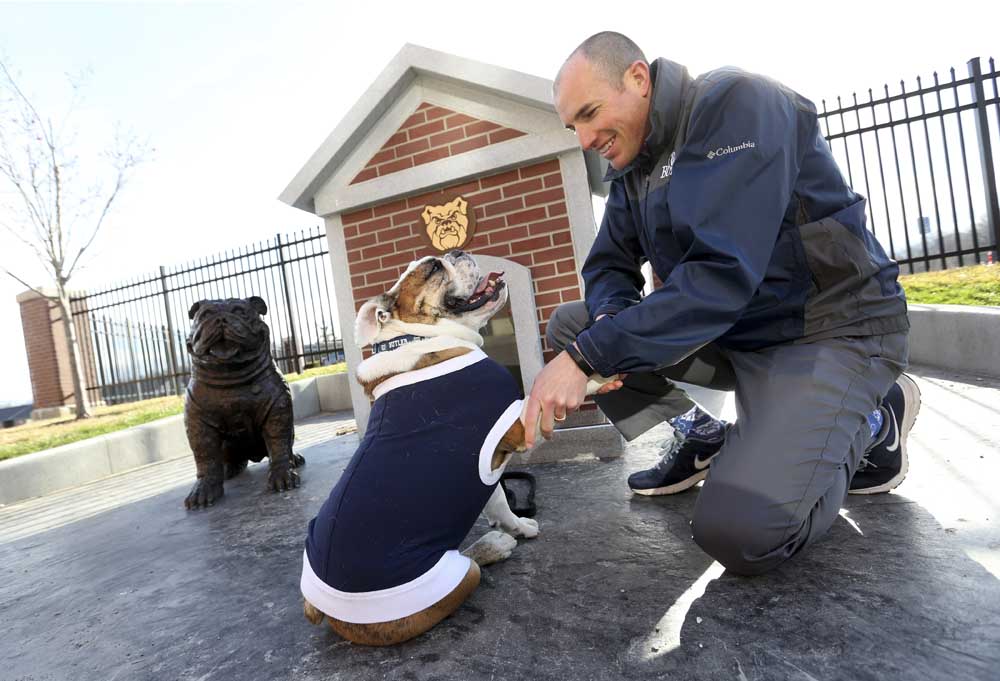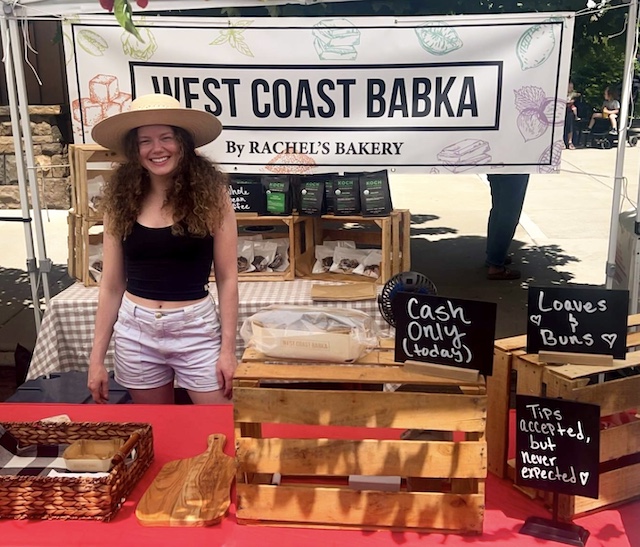When live college mascots live no more
Published 12:00 am Sunday, April 5, 2015

- Photos by Chris Bergin / New York Times News ServiceMichael Kaltenmark, a Butler University official, shakes with his charge, Butler Blue III, the school’s mascot, at the Bulldog Memorial on the Indianapolis campus. BELOW: In death, as in life, mascots that devote themselves to faithful service are beloved symbols.
INDIANAPOLIS — Butler Blue III toddled about in the morning sun last week outside Butler’s basketball court, Hinkle Fieldhouse. He drooled slightly. A 60-pound, 3-year-old purebred white English bulldog, Butler Blue III, known as Trip, has wrinkles over his eyes, speckles of brown on the backs of his ears and a burnt sienna dot atop his skull, part of his red brindled coat. He smelled like a damp towel, though not in an unpleasant way.
Trip was outgoing and, above all, curious: about his surroundings, about a photographer’s equipment, about passers-by. He alternated among panting, making a sound like an ambulance siren and emitting loud, tenor barks.
“He’s just doing it to fight boredom,” said Michael Kaltenmark, his caretaker and Butler’s director for external relations.
Trip thrives when he is excited. His star turn came last month at the Big East tournament, when he threw up on the court and watched Kaltenmark wipe up afterward.
“Oops. I go hard,” Trip posted to his Twitter (which Kaltenmark manages).
On this morning, Trip seemed particularly interested in sniffing a large bronze bust of a dog that looked very much like him. In fact, the sculpture was of Trip’s predecessor Blue II. It sits on a granite platform that also hosts a large A-frame doghouse — red-brick front and marble back. This is the Bulldog Memorial, though technically it is also a mausoleum.
The cremated remains of Trip’s predecessors, Blue I and Blue II, reside in a small panel in the back. Someday, Trip will join them.
“There’s room,” Kaltenmark said. “III can go here. Probably IV as well.”
Trip, not entirely unlike Hamlet contemplating his former jester’s skull, stood at Kaltenmark’s side and drooled.
The live animal mascot is increasingly prevalent in college sports. Sometimes, the animal is impressive but necessarily distant, like Mike the Tiger of Louisiana State. Kentucky’s last live mascot, also nicknamed Blue, was a bobcat.
But others — especially canines — are accessible. They become fixtures of campus life, and with the aid of social media, they establish distinct identities. In short, they can become beloved. And some colleges have decided to treat them the way they treat other beloved figures who have passed on. All dogs go to heaven, but some have elaborate resting places on earth as well.
Georgia’s bulldogs Ugas I through VIII are buried at Sanford Stadium. Seven Reveilles, most of them collies, are interred at the north entrance to Texas A&M’s Kyle Field. The first Reveille was buried in January 1944 with full military honors.
Last month, Victor E. Bulldog II, Fresno State’s live mascot, died after being stung by a bee. He was privately owned and is not buried on campus. His untimely demise has led Fresno State to contemplate whether future Victor E. Bulldogs should be owned by the university.
“I never thought I’d be having the discussion of figuring out what we’re going to do for Victor E. III, just because Victor E. II was 3 years old,” said Paul Ladwig, a senior associate athletic director. “I thought we would have him for 10 years.”
Fresno State could do worse than to follow Butler’s example. The Bulldog Memorial, which was Kaltenmark’s idea, was made possible in part by the class of 2013, which raised more than $10,000 for it.
Michael Couch, the class president, said his classmates had a special relationship with Blue II.
“My senior year was the year Blue II retired,” Couch said in a telephone interview. “He walked across the stage with the whole class. He got an honorary bone.”
The class of 2013 and Blue II also watched their university’s jump in public recognition together.
Despite hailing from Indiana, Couch had barely heard of Butler before applying.
Butler’s first Final Four run — the last time the event was staged at Lucas Oil Stadium, a few miles south of Butler’s campus — was Couch’s freshman year.
Butler’s hardcourt success has paid off for the university. Applications increased nearly 50 percent after the 2010 Final Four, according to Associate Athletic Director Mike Freeman, and have held steady around 10,000 for about 1,000 spots per year, including the year after Butler’s second consecutive Final Four.
It also put Blue II on the map.
“We don’t have big-time football, but I want our dogs to be of that caliber, that recognition,” Kaltenmark said. “Throw in a couple Final Fours, a little magic, and it happened. We were able to do with Blue II what I thought might happen with Blue VI or VII.”
These are the paws Trip has to fill. Blue II held America’s attention and affection during the 2010 tournament, and when Butler returned to the Final Four the following season, the charismatic Blue II was again must-see television. Before one title game, Kaltenmark said, a CBS producer told him that the dog would be featured prominently if Butler won. The Bulldogs were edged by Duke in the 2010 championship, 61-59, and lost to Connecticut in the 2011 title game, 53-41.
Kaltenmark, originally a public-relations and journalism major, masterminded the current Blue program. He wears socks with little bulldog cartoons on them. He lives on campus with his family (and Trip), which is convenient during September football games, because bulldogs have trouble with heat — the reason Georgia’s bulldog has an air-conditioned doghouse. After running onto the field with the team, Trip will often retreat to Kaltenmark’s apartment for a cold bath.
In addition to the breed’s issues with temperature, one other limitation stands out: Bulldogs tend not to live very long — around a decade. Blue II was 9 when he died; Blue I, who had a private owner, was practically ancient at 131⁄2.
On the side of the Bulldog Memorial are plaques commemorating its current residents. Blue I is the “Matriarch of a Legacy.” Blue II is “Butler’s Mascot, America’s Dog.”
How will Trip’s plaque describe him? “When I look at these, I wonder what his epitaph’s going to be,” Kaltenmark said. “It might just be ‘Puke and Rally.’”
If Trip was offended, he did not let on. Standing at Kaltenmark’s side, he drooled.






